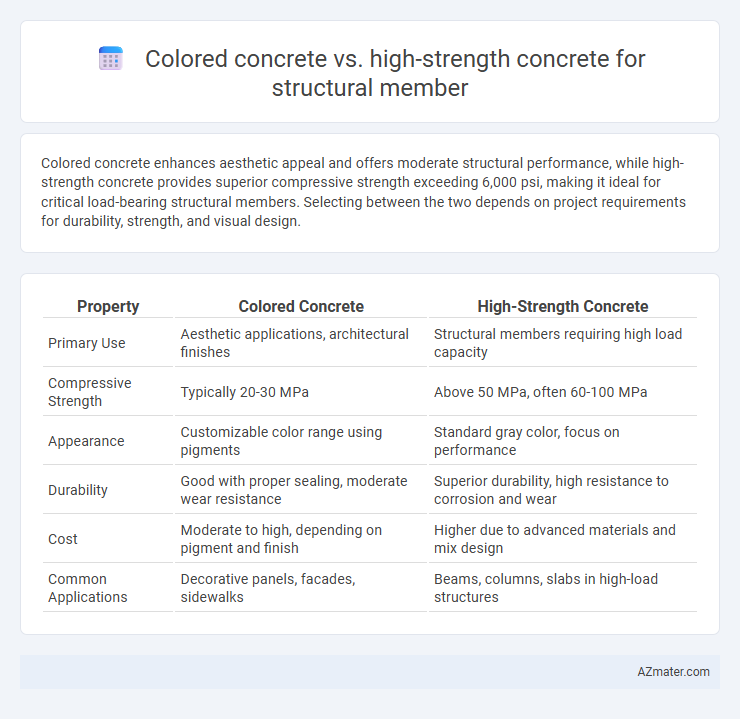Colored concrete enhances aesthetic appeal and offers moderate structural performance, while high-strength concrete provides superior compressive strength exceeding 6,000 psi, making it ideal for critical load-bearing structural members. Selecting between the two depends on project requirements for durability, strength, and visual design.
Table of Comparison
| Property | Colored Concrete | High-Strength Concrete |
|---|---|---|
| Primary Use | Aesthetic applications, architectural finishes | Structural members requiring high load capacity |
| Compressive Strength | Typically 20-30 MPa | Above 50 MPa, often 60-100 MPa |
| Appearance | Customizable color range using pigments | Standard gray color, focus on performance |
| Durability | Good with proper sealing, moderate wear resistance | Superior durability, high resistance to corrosion and wear |
| Cost | Moderate to high, depending on pigment and finish | Higher due to advanced materials and mix design |
| Common Applications | Decorative panels, facades, sidewalks | Beams, columns, slabs in high-load structures |
Introduction to Colored Concrete and High-Strength Concrete
Colored concrete incorporates pigments or dyes to enhance aesthetic appeal without compromising essential structural properties, making it ideal for architectural elements and decorative applications. High-strength concrete is formulated with low water-cement ratios, advanced admixtures, and optimized aggregate grading, achieving compressive strengths exceeding 6,000 psi, essential for load-bearing structural members in high-rise buildings and infrastructure. The choice between colored and high-strength concrete depends on balancing visual design requirements and structural performance criteria.
Key Properties and Composition Differences
Colored concrete contains pigments mixed with cement, sand, and aggregates to achieve aesthetic appeal, while high-strength concrete emphasizes a higher cement content and lower water-cement ratio to enhance compressive strength, typically exceeding 6,000 psi. Key properties of colored concrete prioritize color uniformity and durability under UV exposure, whereas high-strength concrete focuses on optimal microstructure and reduced permeability for superior load-bearing capacity. Composition differences involve the addition of coloring agents and possible surface treatments in colored concrete, contrasted with specialized admixtures like silica fume and superplasticizers in high-strength concrete to improve mechanical performance.
Structural Performance Comparison
Colored concrete offers aesthetic versatility but generally has lower compressive strength and durability compared to high-strength concrete, which is engineered to achieve compressive strengths exceeding 6,000 psi. High-strength concrete provides superior load-bearing capacity, enhanced resistance to environmental stressors, and improved longevity in structural members. While colored concrete is suitable for architectural elements, high-strength concrete remains the preferred choice for critical structural components requiring optimal performance under heavy loads.
Aesthetic Considerations and Design Flexibility
Colored concrete offers extensive aesthetic versatility through customizable pigments and finishes, allowing architects to achieve specific visual effects that enhance structural member appeal. High-strength concrete primarily focuses on mechanical performance with limited color options, often requiring additional surface treatments to meet design aesthetics. This makes colored concrete more suitable for projects where design flexibility and visual impact are priorities alongside structural functionality.
Durability and Longevity Factors
Colored concrete, enhanced with pigments and additives, offers aesthetic appeal while maintaining moderate durability suitable for decorative structural members exposed to mild environmental stress. High-strength concrete, characterized by optimized mix design and low water-cement ratio, delivers superior compressive strength and enhanced resistance to abrasion, chemical attack, and freeze-thaw cycles, ensuring longer service life in critical load-bearing structural elements. Durability performance in high-strength concrete surpasses colored concrete due to its dense microstructure and improved impermeability, making it the preferred choice for longevity in demanding structural applications.
Cost Implications and Budget Considerations
Colored concrete typically incurs higher material and labor costs due to the pigments and specialized mixing processes required, impacting project budgets significantly. High-strength concrete demands higher cement content and quality control measures, which elevate costs but often reduce member sizes and overall material use, potentially offsetting initial expenses. Evaluating the cost-benefit ratio involves balancing the aesthetic advantage of colored concrete against the structural efficiency and long-term savings offered by high-strength concrete in load-bearing applications.
Application Scenarios in Structural Members
Colored concrete is ideal for architectural structural members requiring aesthetic appeal, such as facades, decorative beams, and exposed columns, providing both visual enhancement and durability. High-strength concrete excels in load-bearing structural members like high-rise building columns, bridge piers, and foundation piles, where increased compressive strength and reduced cross-sectional area are critical. Selection depends on balancing structural performance requirements with design intent, where colored concrete emphasizes appearance and high-strength concrete prioritizes mechanical properties.
Environmental Impact and Sustainability
Colored concrete incorporates pigments that do not significantly alter its environmental footprint, making it a sustainable option when combined with recycled aggregates and supplementary cementitious materials. High-strength concrete reduces material usage by offering greater load-bearing capacity, leading to lower overall carbon emissions in structural applications. Both types contribute to sustainability by optimizing resource efficiency, but high-strength concrete often has a higher embodied energy due to its cement content, necessitating careful mix design to minimize environmental impact.
Installation and Maintenance Requirements
Colored concrete requires careful mixing and consistent pigmentation to ensure uniform appearance during installation, often needing specialized equipment or techniques to prevent color variations. High-strength concrete demands precise control of water-cement ratios and admixture content to achieve its performance criteria, with installation requiring skilled labor to handle its lower workability and faster setting times. Maintenance for colored concrete focuses on preserving aesthetic qualities through sealing and cleaning, whereas high-strength concrete emphasizes structural integrity inspections to detect potential micro-cracking or durability issues over time.
Choosing the Right Concrete for Structural Needs
Colored concrete offers aesthetic versatility and surface customization, ideal for architectural elements where visual appeal is crucial. High-strength concrete provides superior compressive strength, making it essential for load-bearing structural members requiring enhanced durability and support. Selecting the right concrete depends on balancing structural demands with design objectives, prioritizing performance specifications such as strength, durability, and appearance.

Infographic: Colored concrete vs High-strength concrete for Structural member
 azmater.com
azmater.com